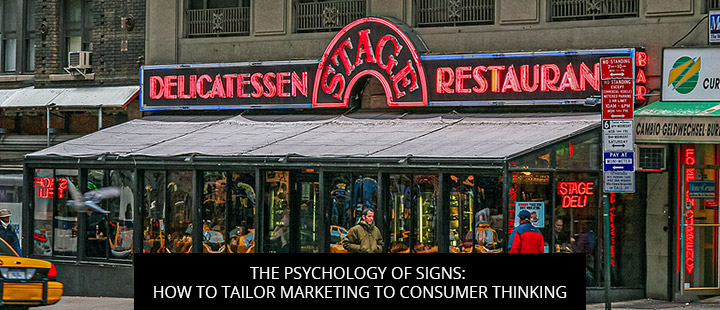Today’s post reviews some fascinating findings on the psychology of sign viewing that you can use to tailor your marketing to specific consumer behaviors. Read on or call 888-765-7446 to get more help from a Signworld partner near you.
Tweak Sign Position For Targeted Psychological Priming
In a recent report by the International Journal of Signage and Wayfinding, researchers explored how different sign positions appealed to different hemispheres of the brain, creating distinct psychological effects.
Several tests suggested that repositioning signs moderated viewers’ receptiveness to different types of marketing messages. When placed squarely in our field of vision, within 1.5 degrees of the focal point, signage sends visual signals to both hemispheres of the brain, left and right. But when the same sign is shifted outside the focal range, we see “contralateral conduction” take place. Put simply, that means signs located on the right side of our field of vision are processed in the left hemisphere, and vice versa.
Because hemispheres have different processing styles, placing your sign to the left or right of your target audience’s field of vision can drastically influence how your message is perceived. In a follow-up study to test this phenomenon, researchers found that pictorial ads placed in the left visual field were evaluated more favorably than those placed in the right visual field, whereas verbal ads performed best in the right visual field.
After analyzing the results of their study, the research team concluded that placing text-heavy signage in the right visual field, and image-heavy signage in the left visual field, “may generate the most positive impact” on passersby.
Accordingly, if you want your signs to make a bigger impact without any design updates required, simply place your graphic signs on the left and your sales copy signage on the right.
Design Your Signage For Better Thin-Slice Judgments
Thin-slice judgment is a term for a psychological process by which people form lasting impressions about things in the world at-a-glance, in “thin slices” or narrow windows of exposure. It is an “effortless, automatic process that takes place without conscious deliberation,” sometimes described as a sort of intuition, an instantaneous impression (Kellaris & Machleit, 2016, p. 8).
Signage is frequently used as the basis for inferential cues and “thin-slice judgements.” We know as much from previous research, like the Sign Research Foundation’s Consumer Perceptions of Retail Signage report, which found that over a third (34.5%) of American consumers make quality assumptions about a business on the basis of clear and attractive signage.
To encourage more favorable thin-slice judgements, Kellaris & Machleit (2016) recommend businesses avoid designing signs under an assumption that “people will stop, read, and think” about their contents, unless you’re ordering specific in-store informational signage for these purposes. Instead, we need to approach our design knowing thin-slicing processing will take place, and favor more accessible cues (e.g. bright colors, sharp design, attractive patterning, clear contrast, etc) over dense blocks of text.
Unlock With Psychology Of Signs With A Local Signworld Partner
Call 888-765-7446 or visit the Signworld business alliance website for help finding a qualified Signworld partner in your area.




